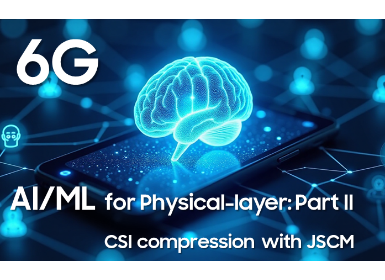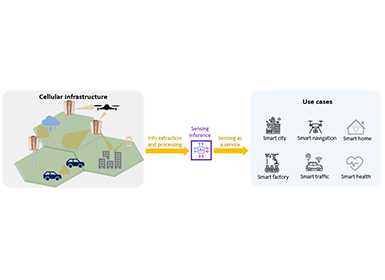Communications
A Signature Based Approach Towards Global Channel Charting with Ultra Low Complexity
Background
Channel charting (CC) is an unsupervised learning method that uses channel information (CI) to extract a low-dimensional embedding (i.e., the chart) that preserves geometrical structure of physical space of user equipments (UEs), which facilitates a broad distance-based or location-based applications, such as handover, indoor localization, beam management, pilot management, and so on [1]. Thus, CC is an attractive and promising approach to enable many applications in beyond 5G and 6G systems. However, many previous works mainly focus on charting that only preserves local geometry, and use raw channel information, such as channel impulse response (CIR), channel frequency response or CI in angular domain, to learn the chart, which do not consider the global geometry and are often computationally intensive and very time-consuming.
Therefore, in this blog, a signature based approach that generates a global chart with ultra low complexity is proposed. Instead of using truncation or downsampling to reduce the number of channel features, we take a totally opposite way, in which the dimensionality of raw discrete CIRs is firstly lifted to form continuous functions and then reduced significantly to obtain a compact feature map by using signature transform, an iterated-integrals based transformation. The signature transform is a nonlinear mapping from a path (continuous mapping) to an infinite sequence called signature, which was originally introduced by [2]. The signature provides a well summary of the path and has meaningful interpretations from the geometrical or statistical viewpoint. With the proposed feature map, a signature based principal component analysis (SPCA) is proposed for CC, in which the dimensionality of the covariance matrix is very small and only proportional to the number of BSs. Moreover, a signature based Siamese network (SSN) for CC is also proposed, in which the signature distance, measured without calculating geodesic distance or constructing neighborhood graph, is valid for both local and global geometry.
Method

Figure 1. The proposed signature based global channel charting.
Consider a single-input single-output (SISO) communication system in which UEs communicate to N_b base stations (BSs). We have a dataset with D samples of raw CIRs for all links between BSs and any UE, which can be denoted as a set of matrices with each sample H_i being a N_b×2N real matrix, and N is the number of channel taps. With this dataset, the objective of CC is to learn a two (or three) dimensional embedding such that the spatial geometry of actual UE locations is preserved in the chart.
An illustration of the proposed method is shown in Fig.1, which includes the signature map generation, signature based PCA (SPCA) and signature based Siamese network (SSN) for CC. In general, we first transform each H_i into a N_b×L matrix with L << N, called signature map, as shown in Fig.1 (a). Then we use this signature map to perform a further dimensionality reduction to obtain the final chart. On one hand, the vectorized signature map can be used as the input of PCA to obtain a channel chart, as shown in Fig.1 (b). Note that we only need to calculate the singular value decomposition (SVD) of a N_b L×N_b L matrix, which is significantly faster than PCA with raw CIRs. As shown in our experiments, a small length of signature with L=6 is enough to generate a good chart. Moreover, unlike other nonparametric approaches, such as Isomap, t-distributed stochastic neighbor embedding (t-SNE) and Laplacian eigenmap, PCA can be easily used to predict on unseen data, which is more suitable for CC. On the other hand, we also propose a SSN based CC, as shown in Fig.1 (c). With the reduced input feature number, the computational complexity and parameter number of the neural network can be reduced significantly.
To obtain the signature map, we need to construct a proper path from the raw discrete sequence. Specifically, the first step is to normalize the total energy of CIR, which can remove the scaling problem owing to the large-scale fading. After that, we calculate the cumulative sum of energy (CSE) sequence. The CSE sequence is non-decreasing, which makes the resulting features of signature have meaningful interpretations from geometrical or physical viewpoint. Then we make a time and basepoint augmentation by adding a corresponding time sequence and a two-tuple zero point at the start. The resulting sequence preserves the full information of time and energy of the raw CIR, which is further formed to the desired path by linear interpolation and the signature features by iterated-integrals. At last, the obtained signature is further normalized across the dataset so that each feature is zero-mean and unit-variance.
Experiments
The proposed method is evaluated in a synthetic dataset in the scenario of indoor factory with dense clutter and high base station (InF-DH) from the 3rd Generation Partnership Project (3GPP) [3]. Each sample in the dataset consists of CIRs from N_b=18 BSs, and the number of tap is N=256. We transform each sample into a N_b×L signature map with L=6 representing the number of signature features. Compared with the dimensionality of CIRs, the feature number has been reduced more than 97%, which means a significant reduction in complexity for subsequent procedures of CC. The performance of local similarity for CC is evaluated in terms of the continuity (CT) and trustworthiness (TW) [1]. The value of these two metrics ranges from 0 to 1, and neighbor points that are embedded far away from each other decrease CT, whereas far away points that are embedded as neighbor points decrease TW. For measuring global dissimilarity, we perform an affine transformation from the chart to real coordinates and evaluate the mean absolute errors (MAE) and the 90th-percentile of the cumulative distribution function of the error (CE90) in units of meters. We randomly choose 100 labeled samples to obtain the least-squares estimation of the affine matrix and perform 1K experiments to obtain the mean and standard deviation of MAE and CE90. Moreover, the proposed SPCA and SSN are compared with CIR based methods including CIR magnitude based PCA or Siamese network. For SSN based CC, we further evaluate two approaches, namely the full SSN (FSSN) and partial SSN (PSSN) based charting. FSSN uses the signature map as network input and also uses it to produce the pairwise distance matrix, and the PSSN only uses the signature map as network input and the pairwise distance matrix is generated by calculating CIR geodesic distance [4].

Figure 2. Ground-truth UE locations and CC results after affine transformation for InF-DH dataset.

Table 1. Experimental results for InF-DH dataset
The true UE locations and the charting results after affine transformation is given in Fig.2, and detailed results for all evaluated methods are given in Table I. For PCA based CC, we select one vector from the signature map for each sample to do PCA, which means we only need to do SVD for an 18×18 covariance matrix rather than a 4608×4608 matrix for CIR based PCA. Moreover, SPCA shows better results on global performance in terms of MAE and CE90 and slightly degraded local similarity in terms of CT and TW, compared with CIR based PCA. For Siamese network based CC, both FSSN and PSSN show better results on global performance and similar results on local similarity in comparison of CIR based method. It thus implies that better performance and significant complexity reduction can be achieved simultaneously with our proposed method.
Conclusion
In this blog, a novel signature based approach for global CC is proposed, in which a compact signature map is extracted from CIRs and can be used for PCA or Siamese network based CC. The experimental results show that the proposed approach can achieve better performance than CIR based methods with significantly reduced complexity.
References
[1] C. Studer, S. Medjkouh, E. Gonultas, et al. “Channel charting: locating users within the radio environment using channel state information,” IEEE Access, vol. 6, pp. 47 682-47 698, Aug. 2018.
[2] K. T. Chen, “Integration of paths, geometric invariants and a generalized Baker-Hausdorff formula,” Annals of Mathematics, Vol.65, No.1, pp. 163-178, Jan., 1957.
[3] 3GPP, TR. 28.901 V16.1.0, “Study on channel model for frequencies from 0.5 to 100GHz (Rel-16)”, 2019.
[4] M. Stahlke, G. Yammine, T. Feigl, et al. “Indoor localization with robust global channel charting: a time-distance-based approach,” IEEE Transactions on Machine Learning in Communications and Networking, vol.1, pp.3-17, Mar. 2023.






